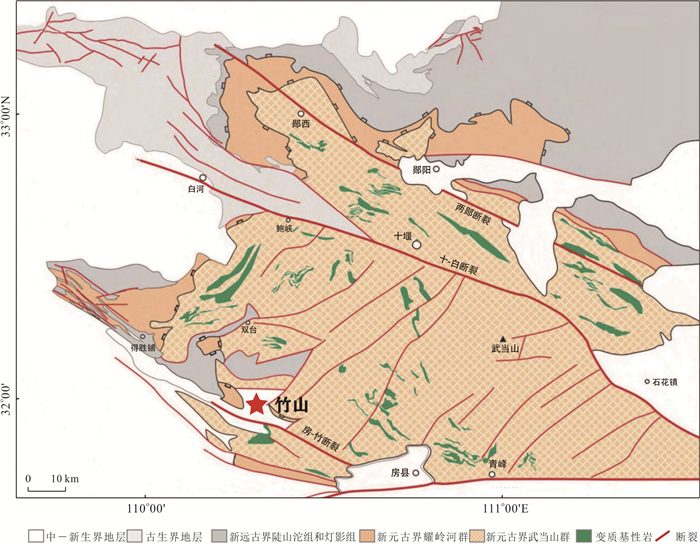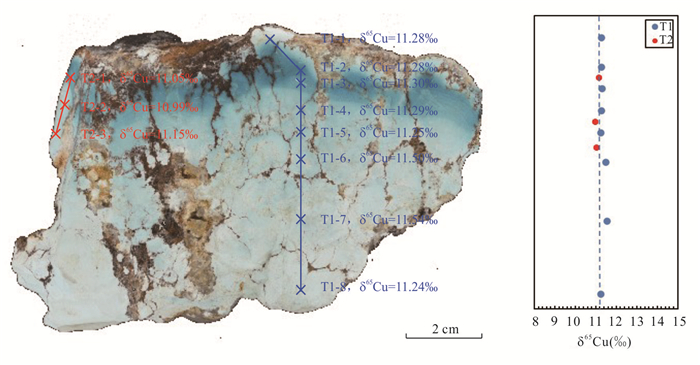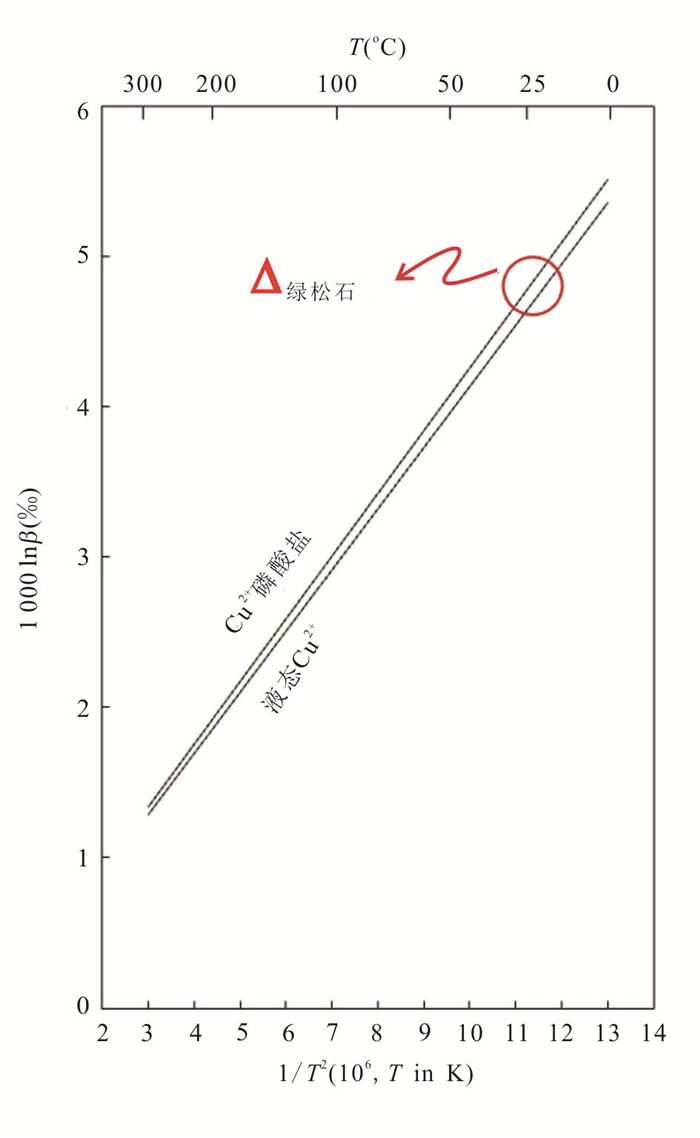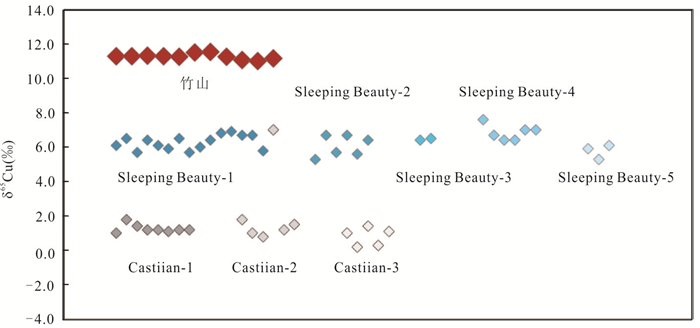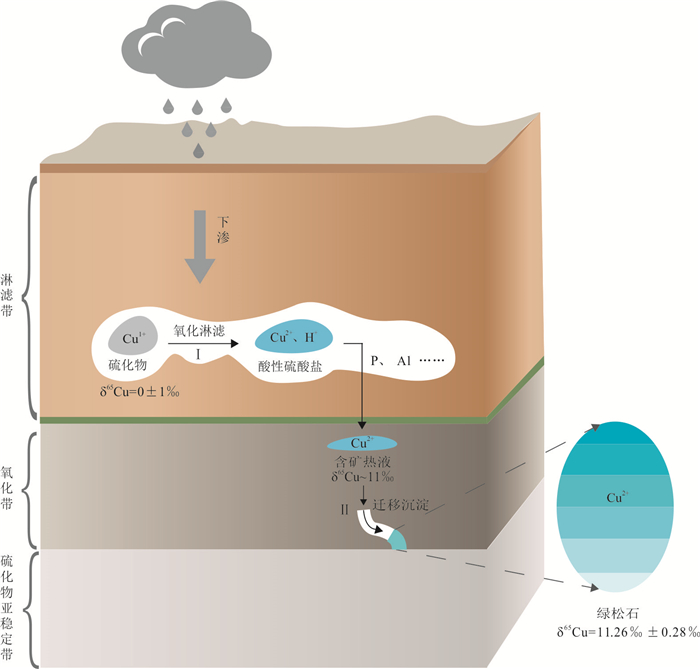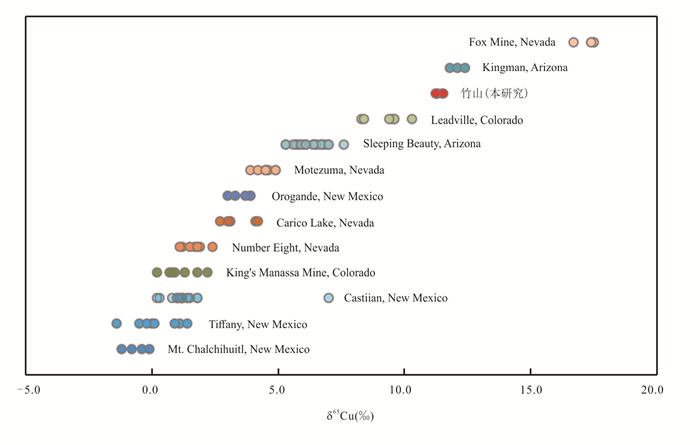Copper Isotopic Variation of Turquoise in Low-Temperature Growth Process and Its Significance for Origin Traceability
-
摘要: 绿松石(CuAl6(PO4)4(OH)8·4(H2O))是重要的表生宝石矿物,已有研究采用绿松石主量元素Cu的同位素进行产地溯源,但是溯源机理不明确.此外,绿松石生长过程复杂,该过程是否造成Cu同位素组成的显著变化还不甚清楚,这限制了其产地溯源的应用.湖北省竹山县是全球最大的宝石级绿松石产出地,采用MC-ICP-MS对竹山县条带状绿松石的生长条带进行高精度Cu同位素测试.结果表明:绿松石δ65Cu值较高,然而不同条带没有明显变化(δ65Cu=10.99‰~11.54‰).绿松石含矿热液沉淀过程分馏有限(< 1‰),这指示绿松石Cu同位素显著变化主要发生在含矿热液的形成过程.原生硫化物的δ65Cu=0±1‰,显著低于绿松石样品测定值,推测引起含矿热液Cu同位素显著分馏的主要原因是原生硫化物发生氧化作用.全球典型绿松石矿区的数据整体与该结果一致,表明绿松石Cu同位素组成主要受源区环境的控制;同一矿区中形成的绿松石,即使经历周期生长产生条带状结构,其Cu同位素组成基本一致.该研究深入探究了Cu同位素示踪绿松石矿区的机理,同时也加深了对低温过程Cu同位素分馏的认识.Abstract: Turquoise (CuAl6(PO4)4(OH)8·4(H2O)) is an important supergene gemstone mineral. The isotope of Cu, its major component, has been increasingly used to trace the origin of such gemstone. However, the tracing mechanism is not clear. Besides, it is still unclear whether Cu isotope composition changes significantly or not during the complex growth of turquoise, limiting the reliable application of trace ability via Cu isotope. In this work it used MC-ICP-MS instrument to measure the Cu isotopic compositions of banded turquoise, which were obtained from Zhushan County, the largest gem-grade deposit of turquoise in the world.The results show that the values of Cu isotopes are very high, however, they are remarkably identical in different bands of the turquoise sample (δ65Cu=10.99‰-11.54‰).The Cu isotope fractionation, in the precipitation of ore-bearing hydrothermal solution, thus has been limited (< 1‰). Instead, the significant fractionation of Cu isotope would occur mainly during the formation of ore-bearing hydrothermal solution. The Cu isotope composition of primary Cu sulfides lies usually within the range of 0±1‰, significantly lower than the value measured in this study, suggesting that the oxidation of the primary sulfide in the source area is the major factor for the significant fractionation of Cu isotope in the ore-bearing hydrothermal solution. The results are consistent with the data of typical turquoise deposits in the world, which confirms that the Cu isotopic composition of turquoise is mainly controlled by the source environment.Even though the turquoise has experienced periodic growth and produced banded structure, the Cu isotope of turquoises formed in the same mine hardly change. This work has explored the mechanism of tracing the origin of turquoise deposits via Cu isotope, and better understanded Cu isotope fractionation in low-temperature hydrothermal process.
-
Key words:
- turquoise /
- growth band /
- Cu isotope fractionation /
- oxidation /
- origin traceability /
- geochemistry
-
图 2 湖北竹山县区域地质图(据岳素伟和邓小华,2019)
Fig. 2. Geological map of Zhushan County, Hubei Province(modified from Yue and Deng (2019))
图 4 温度与lnβ的函数
液态Cu2+和Cu2+磷酸盐的lnβ值表现为T2-的线性函数Fujii et al.(2013, 2014)
Fig. 4. Temperature dependence of lnβ
图 5 绿松石δ65Cu值
来自本研究中的竹山矿区内1个手标本样品、美国Sleeping Beauty矿区内5个矿点的绿松石样品和新墨西哥Castiian矿区内3个矿点的绿松石样品(Hull et al., 2008)
Fig. 5. δ65Cu values of turquoises
图 7 不同矿区绿松石的δ65Cu值对比
其他数据来自Hull et al.(2008)
Fig. 7. Comparison of δ65Cu values of turquoises obtained from different mining areas
表 1 绿松石不同生长条带的δ65Cu值(‰)
Table 1. δ65Cu values of different growth bands of turquoise (‰)
样品点号 T1-1 T1-2 T1-3 T1-4 T1-5 T1-6 T1-7 T1-8 T2-1 T2-2 T2-3 δ65Cu 11.28 11.28 11.30 11.29 11.25 11.50 11.54 11.24 11.05 10.99 11.15 2SD 0.03 0.06 0.01 0.14 0.06 0.02 0.06 0.03 0.04 0.19 0.01 -
Chávez, W.X., 2000. Supergene Oxidation of Copper Deposits: Zoning and Distribution of Copper Oxide Minerals. SEG Discovery, (41): 1-21. https://doi.org/10.5382/segnews.2000-41.fea Chen, D.D., Song, S.M., Ryan, M., et al., 2016. Copper Isotopic Characteristics of the Water System in the Dexing Copper Deposit, Jiangxi Province, and Their Geological Significance. Geological Bulletin of China, 35(1): 188-195(in Chinese with English abstract). Chen, Q.L., Yuan, X.Q., Chen, J.Z., et al., 2010. Structural Characteristics of Turquoise Filled with Aluminum Phosphate Adhesive. Earth Science, 35(6): 1023-1028(in Chinese with English abstract). https://en.cnki.com.cn/Article_en/CJFDTotal-DQKX201006013.htm Ehrlich, S., Butler, I., Halicz, L., et al., 2004. Experimental Study of the Copper Isotope Fractionation between Aqueous Cu(Ⅱ) and Covellite, CuS. Chemical Geology, 209(3/4): 259-269. https://doi.org/10.1016/j.chemgeo.2004.06.010 Evans, M.J., Fayek, M., Riciputi, L., et al., 2004. LA-MC-ICPMS Determination of Copper Isotope Ratios in Turquoise from the Southwestern United States. In: EOS, Transactions, American Geophysical Union. American Geophysical Union, Fall Meeting, abstract, V51A-0514. Foord, E.E., Taggart, J.E. Jr, 1998. A Reexamination of the Turquoise Group: The Mineral Aheylite, Planerite (Redefined), Turquoise and Coeruleolactite. Mineralogical Magazine, 62(1): 93-111. https://doi.org/10.1180/002646198547495 Fu, B.G., Hou, Q.Y., 2017. Mineralogical Characteristics and Metallogenic Geological Conditions of Turquoise. Huabei Land and Resources, (5): 33-34(in Chinese with English abstract). Fujii, T., Moynier, F., Abe, M., et al., 2013. Copper Isotope Fractionation between Aqueous Compounds Relevant to Low Temperature Geochemistry and Biology. Geochimica et Cosmochimica Acta, 110: 29-44. https://doi.org/10.1016/j.gca.2013.02.007 Fujii, T., Moynier, F., Blichert-Toft, J., et al., 2014. Density Functional Theory Estimation of Isotope Fractionation of Fe, Ni, Cu, and Zn among Species Relevant to Geochemical and Biological Environments. Geochimica et Cosmochimica Acta, 140: 553-576. https://doi.org/10.1016/j.gca.2014.05.051 Greenwood, N.N., Whitfield, H.J., 1968. Mössbauer Effect Studies on Cubanite (CuFe2S3) and Related Iron Sulphides. J. Chem. Soc. A, 1697-1699. https://doi.org/10.1039/j19680001697 Hu, W.F., Zhang, Y.K., Liu, J.H., et al., 2019. The Isotopic Compositions of Copper and Molybdenum from Porphyry Cu-Mo Deposit in the Gangdese, Tibet, and Their Significance. Earth Science, 44(6): 1923-1934(in Chinese with English abstract). https://jglobal.jst.go.jp/en/detail?JGLOBAL_ID=201902294463229551 Hull, S., Fayek, M., Mathien, F.J., et al., 2008. A New Approach to Determining the Geological Provenance of Turquoise Artifacts Using Hydrogen and Copper Stable Isotopes. Journal of Archaeological Science, 35(5): 1355-1369. https://doi.org/10.1016/j.jas.2007.10.001 Hull, S., Fayek, M., Mathien, F.J., et al., 2014. Turquoise Trade of the Ancestral Puebloan: Chaco and Beyond. Journal of Archaeological Science, 45: 187-195. https://doi.org/10.1016/j.jas.2014.02.016 Ji, J., Zhao, H.X., 2017. Mechanism and Factors Influencing Copper Isotopic Fractionation: A Review. Advances in Geosciences, 7(3): 336-348 (in Chinese with English abstract). doi: 10.12677/AG.2017.73037 Jiang, Z.C., Chen, D.M., Wang, F.Y., et al., 1983. Thermal Properties of Turquoise and Its Intergrowing Minerals in a Certain District of China. Acta Mineralogica Sinica, 3(3): 198-206, 247(in Chinese with English abstract). https://en.cnki.com.cn/Article_en/CJFDTOTAL-KWXB198303006.htm Kim, J., Simon, A.W., Ripoche, V., et al., 2003. Proton-Induced X-Ray Emission Analysis of Turquoise Artefacts from Salado Platform Mound Sites in the Tonto Basin of Central Arizona. Measurement Science and Technology, 14(9): 1579-1589. https://doi.org/10.1088/0957-0233/14/9/309 Ku, Y.L., Yang, M.X., 2021. Study on Spectral Characteristics of Turquoise with Blue"Water Ripple" from Shiyan, Hubei Province. Spectroscopy and Spectral Analysis, 41(2): 636-642(in Chinese with English abstract). Ku, Y.L., Yang, M.X., Li, Y., 2020. Spectroscopic Study of Green-Yellow and Green Turquoise Associated Minerals from Zhushan, Hubei Province. Spectroscopy and Spectral Analysis, 40(6): 1815-1820(in Chinese with English abstract). https://jglobal.jst.go.jp/en/detail?JGLOBAL_ID=202002280973030150 Larson, P.B., Maher, K., Ramos, F.C., et al., 2003. Copper Isotope Ratios in Magmatic and Hydrothermal Ore-Forming Environments. Chemical Geology, 201(3-4): 337-350. https://doi.org/10.1016/j.chemgeo.2003.08.006 Li, J.Z., 1994. Jade and Resource Development. Mineral Resources and Geology, 8(3): 213-217(in Chinese with English abstract). doi: 10.1007/0-387-26350-0_5 Li, Y.X., Xian, Y.H., 2015. Provenance Studies of Ancient Turquoise in America. Sciences of Conservation and Archaeology, 27(2): 102-109(in Chinese with English abstract). https://pubs.geoscienceworld.org/gsa/gsabulletin/article-abstract/127/11-12/1617/126096/Isotopic-evidence-for-the-provenance-of-turquoise Lin, C.Q., Hu, M., He, H.T., 2006. Ore-Control Condition and Ore-Searching Direction of Ag-Au Polymetal Deposits in Wudang Area, Hubei Province. Contributions to Geology and Mineral Resources Research, 21(2): 104-108(in Chinese with English abstract). https://en.cnki.com.cn/Article_en/CJFDTOTAL-DZZK200602007.htm Liu, S.G., Li, D.D., Li, S.G., et al., 2014. High-Precision Copper and Iron Isotope Analysis of Igneous Rock Standards by MC-ICP-MS. Journal of Analytical Atomic Spectrometry, 29(1): 122-133. https://doi.org/10.1039/C3JA50232E Maher, K.C., Jackson, S., Mountain, B., 2011. Experimental Evaluation of the Fluid-Mineral Fractionation of Cu Isotopes at 250 ℃ and 300 ℃. Chemical Geology, 286(3-4): 229-239. https://doi.org/10.1016/j.chemgeo.2011.05.008 Maréchal, C.N., Télouk, P., Albarède, F., 1999. Precise Analysis of Copper and Zinc Isotopic Compositions by Plasma-Source Mass Spectrometry. Chemical Geology, 156(1-4): 251-273. https://doi.org/10.1016/S0009-2541(98)00191-0 Mathur, R., Titley, S., Barra, F., et al., 2009. Exploration Potential of Cu Isotope Fractionation in Porphyry Copper Deposits. Journal of Geochemical Exploration, 102(1): 1-6. https://doi.org/10.1016/j.gexplo.2008.09.004 Othmane, G., Hull, S., Fayek, M., et al., 2015. Hydrogen and Copper Isotope Analysis of Turquoise by SIMS: Calibration and Matrix Effects. Chemical Geology, 395: 41-49. https://doi.org/10.1016/j.chemgeo.2014.11.024 Paige, S., 1912. The Origin of Turquoise in the Burro Mountains, New Mexico. Economic Geology, 7(4): 382-392. https://doi.org/10.2113/gsecongeo.7.4.382 Shi, Z.R., Cai, K.Q., 2011. A Study of the Origin of Turquoise Deposite in Zhushan County, Hubei Province. Acta Petrologica et Mineralogica, 30(S1): 187-194 (in Chinese with English abstract). Thibodeau, A.M., López Luján, L., Killick, D.J., et al., 2018. Was Aztec and Mixtec Turquoise Mined in the American Southwest? Science Advances, 4(6): eaas9370. https://doi.org/10.1126/sciadv.aas9370 Thibodeau, A.M., Killick, D.J., Hedquist, S.L., et al., 2015. Isotopic Evidence for the Provenance of Turquoise in the Southwestern United States. Geological Society of America Bulletin, 127(11/12): 1617-1631. https://doi.org/10.1130/b31135.1 Tu, H.K., 1996. Geological Characteristics of Turquoise Ore in the Areas Adjacent to Shaanxi and Hubei Provinces. Geology of Shaanxi, 14(2): 59-64(in Chinese with English abstract). https://www.sciencedirect.com/science/article/abs/pii/S1875510016300695 Venendaal, J.F., 2007. Trace Element Geochemistry and Carbonate Alteration as Indicators for Gold Mineralization at the Cortez Hills Deposit, Lander County, Nevada(Dissertation). Colorado School of Mines, Colorado. Wall, A.J., Mathur, R., Post, J.E., et al., 2011. Cu Isotope Fractionation during Bornite Dissolution: An In Situ X-Ray Diffraction Analysis. Ore Geology Reviews, 42(1): 62-70. https://doi.org/10.1016/j.oregeorev.2011.01.001 Wang, Z.C., Park, J.W., Wang, X., et al., 2019. Evolution of Copper Isotopes in Arc Systems: Insights from Lavas and Molten Sulfur in Niuatahi Volcano, Tonga Rear Arc. Geochimica et Cosmochimica Acta, 250: 18-33. https://doi.org/10.1016/j.gca.2019.01.040 Weber, R.H., ol Mines, N.M.B., 1979. Turquoise in New Mexico. New Mexico Geology, 1: 39-40. Xu, F., 2017. Study on Turquoise in Shiyan City, Hubei Province. Shanghai Art & Crafts, (3): 30-32(in Chinese with English abstract). Yue, S.W., Deng, X.H., 2019. Geological and Ore-Forming Characteristics of Ag-Au and Polymetallic Deposits in Northwestern Hubei, China. Earth Science Frontiers, 26(5): 106-128(in Chinese with English abstract). Zhu, X.K., Guo, Y., Williams, R.J.P., etal., 2002. Mass Fractionation Processes of Transition Metal Isotopes. Earth and Planetary Science Letters, 200(1/2): 47-62. https://doi.org/10.1016/S0012-821X(02)00615-5 Zhu, X.K., Wang, Y., Yan, B., et al., 2013. Developments of Non-Traditional Stable Isotope Geochemistry. Bulletin of Mineralogy, Petrology and Geochemistry, 32(6): 651-688(in Chinese with English abstract). https://www.researchgate.net/publication/273766379_Developments_of_Non-Traditional_Stable_Isotope_Geochemistry 陈丹丹, 宋世明, Mathur Ryan, 等, 2016. 江西德兴铜矿区水系的Cu同位素地球化学特征及其地质意义. 地质通报, 35(1): 188-195. doi: 10.3969/j.issn.1671-2552.2016.01.018 陈全莉, 袁心强, 陈敬中, 等, 2010. 磷酸铝结合剂改性绿松石的结构特征. 地球科学, 35(6): 1023-1028. doi: 10.3799/dqkx.2010.115 付宝国, 侯青亚, 2017. 绿松石的矿物学特征及成矿地质条件. 华北国土资源, (5): 33-34. doi: 10.3969/j.issn.1672-7487.2017.05.016 胡文峰, 张烨恺, 刘金华, 等, 2019. 西藏冈底斯斑岩型铜钼矿床的Cu、Mo同位素组成及其意义. 地球科学, 44(6): 1923-1934. doi: 10.3799/dqkx.2019.077 嵇静, 赵海香, 2017. 铜同位素分馏机理及影响因素研究综述. 地球科学前沿, 7(3): 336-348. doi: 10.12677/AG.2017.73037 姜泽春, 陈大梅, 王辅亚, 等, 1983. 湖北、陕西一带绿松石的热性能及其共生矿物. 矿物学报, 3(3): 198-206, 247. doi: 10.3321/j.issn:1000-4734.1983.03.006 库雅伦, 杨明星, 2021. 湖北十堰蓝色"水波纹"绿松石的谱学特征. 光谱学与光谱分析, 41(2): 636-642. https://www.cnki.com.cn/Article/CJFDTOTAL-GUAN202102057.htm 库雅伦, 杨明星, 李妍, 2020. 湖北竹山黄绿色-绿色绿松石伴生矿的谱学研究. 光谱学与光谱分析, 40(6): 1815-1820. https://www.cnki.com.cn/Article/CJFDTOTAL-GUAN202006032.htm 李家珍, 1994. 玉石及其资源开发(4). 矿产与地质, 8(3): 213-217. https://www.cnki.com.cn/Article/CJFDTOTAL-KCYD403.010.htm 李延祥, 先怡衡, 2015. 美国古代绿松石示踪研究. 文物保护与考古科学, 27(2): 102-109. doi: 10.3969/j.issn.1005-1538.2015.02.016 林长谦, 胡明, 何洪涛, 2006. 湖北武当地区银金多金属矿控矿条件及找矿方向. 地质找矿论丛, 21(2): 104-108. doi: 10.3969/j.issn.1001-1412.2006.02.007 石振荣, 蔡克勤, 2011. 湖北省竹山县绿松石矿床成因研究. 岩石矿物学杂志, 30(S1): 187-194. 涂怀奎, 1996. 陕鄂相邻地区绿松石矿地质特征. 陕西地质, 14(2): 59-64. https://www.cnki.com.cn/Article/CJFDTOTAL-SXDY199602006.htm 徐飞, 2017. 湖北十堰绿松石探究. 上海工艺美术, (3): 30-32. https://www.cnki.com.cn/Article/CJFDTOTAL-SGYM201703011.htm 岳素伟, 邓小华, 2019. 鄂西北地区银金多金属矿床地质特征与成矿规律. 地学前缘, 26(5): 106-128. https://www.cnki.com.cn/Article/CJFDTOTAL-DXQY201905011.htm 朱祥坤, 王跃, 闫斌, 等, 2013. 非传统稳定同位素地球化学的创建与发展. 矿物岩石地球化学通报, 32(6): 651-688. https://www.cnki.com.cn/Article/CJFDTOTAL-KYDH201306002.htm -









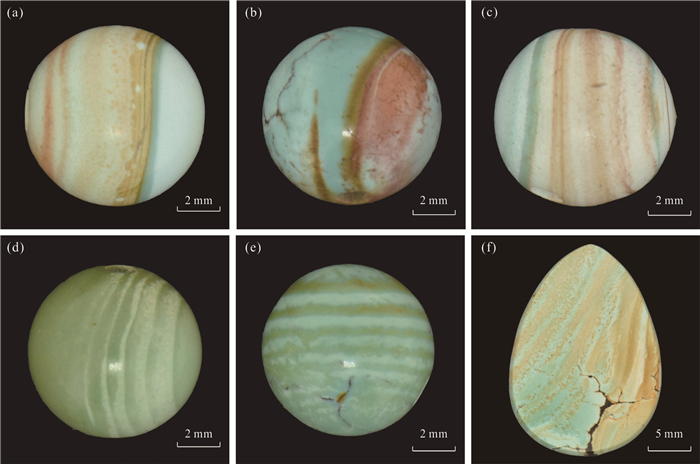
 下载:
下载:
